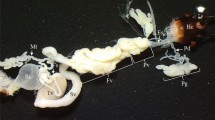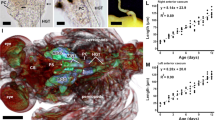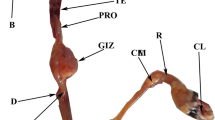Abstract
An internal anatomy of the adult female pink mealybug, Maconelicoccus hirsutus (Green) (Hemiptera: Coccoidea: Pseudococcidae) was examined using stereo microscopy with an aim to explicate the alimentary canal, Malpighian tubules, nervous system, respiratory system and muscular arrangement at the morphological levels. Results revealed that the alimentary canal consisted of a foregut (pharynx and oesophagus), filter chamber, midgut (Dilated sac or stomach, anterior midgut and posterior midgut) and hind gut (Ileum and rectum). The filter chamber enclosed with posterior extremity of oesophagus, anterior midgut, posterior midgut, anterior extremity of ileum and rectum. A pair of well-developed salivary glands were located both the sides of oesophageal tube. Two Malpighian tubules, almost the length of insect body run alongside the hindgut. Nervous system mainly composed of supraoesophageal ganglion, suboesophageal ganglion and thoracicoabdominal ganglion. Tracheal trunks emerged from four spiracles were surrounded by wax glands on its basal region. Reproductive system composed of a pair of tube like ovaries, many number of ovarioles on ovariole buds and short globular shape spermatheca. Ventral longitudinal muscles emerged from thoracic furca, were arranged in diamond shape on ventral floor while innervating mouth, leg and genital region. The study provides an insight about the arrangement of internal organs and their morphological features of pink mealybug.








Similar content being viewed by others
References
Aristizábal LF, Mannion C, Bergh C, Arthurs S (2012) Life history of Pink Hibiscus Mealybug, Maconellicoccus Hirsutus (Hemiptera: Pseudococcidae) on three Hibiscus Rosa-Sinensis cultivars. Fla Entomol 95:89–94
Ben-Dov Y, Gibson GAP (2015) ScaleNet: Scale Insects. Coccoidea Database
Chong J-H, Aristizábal LF, Arthurs SP (2015) Biology and Management of Maconellicoccus hirsutus (Hemiptera: Pseudococcidae) on ornamental plants. J Integr Pest Manag 6:5. https://doi.org/10.1093/jipm/pmv004
Downie DA, Gullan PJ (2004) Phylogenetic analysis of mealybugs (Hemiptera: Coccoidea: Pseudococcidae) based on DNA sequences from three nuclear genes, and a review of the higher classification. Syst Entomol 29:238–260. https://doi.org/10.1111/j.0307-6970.2004.00241.x
Foldi I (1997) 1.1.2.6 internal anatomy of the adult female. In: Ben-Dov Y, Hodgson CJ (eds) World Crop Pests. Elsevier, pp 73–90
Franco JC, Zada A, Mendel Z (2009) Novel approaches for the management of Mealybug Pests. In: Ishaaya I, Horowitz AR (eds) Biorational Control of Arthropod Pests: application and Resistance Management. Springer Netherlands, Dordrecht, pp 233–278
Ghanim M, Rosell RC, Campbell LR et al (2001) Digestive, salivary, and reproductive organs of Bemisia tabaci (Gennadius) (Hemiptera: Aleyrodidae) B type. J Morphol 248:22–40. https://doi.org/10.1002/jmor.1018
Hough WS (1925) The Internal anatomy of the Clover Root Mealy-bug, Trionymus trifolii, Forbes (Homoptera, Coccidae). Bull Entomol Res 16:25–29. https://doi.org/10.1017/S000748530005611X
Lalitha N, Kumar MV, Saha AK, Kumar SN (2015) Avoidable Mulberry leaf yield loss due to Pink mealy bug, Maconellicoccus hirsutus. Ann Plant Prot Sci 23:171–172
Mani M, Krishnamoorthy A (2001) Suppression of Maconellicoccus hirsutus (Green) on guava. Insect Environment 6(4)
Manjunath TM (1985) India - Maconellicoccus hirsutus on grapevine. FAO Plant Protection Bulletin 33(2)
Miller DR, Miller GL, Watson GW (2002) Invasive species of mealybugs (Hemiptera: Pseudococcidae) and their threat to U.S. agriculture. P Entomol Soc Wash 104:825–836
Misra CS (1920) Tukra Disease of Mulberry. Report of Proceedings 3rd Ent Meeting, Pusa, February 1919 2
Ramesha C, Seshagiri SV, Lakshmi H et al (2010) Effect of Tukra (Mealybug) infected Mulberry Leaves on the quantitative traits of New Polyvoltine strain of Silkworm, Bombyx mori L. J Entomol 6:207–214. https://doi.org/10.3923/je.2009.207.214
Ranjan R (2006) Economic impacts of Pink Hibiscus Mealybug in Florida and the United States. Stoch Environ Res Ris Assess 20:353–362. https://doi.org/10.1007/s00477-005-0027-0
Sathyaprasad K, Manjunath D, Rajan MV, Sarkar A (2000) Screening of mulberry germplasm for tolerance to sucking pest. In National Conference on Strategies for sericulture research and development, Central Sericultural Research and Training Institute, Mysore
Savage RE (1914) The respiratory system of Monophlebus stebbingi, var. Octocaudata. Bull Entomol Res 5:45–47. https://doi.org/10.1017/S0007485300034520
Sollai G, Solari P (2022) An overview of “Insect Biodiversity. Diversity 14:134. https://doi.org/10.3390/d14020134
Stork NE (2018) How many species of insects and other Terrestrial Arthropods are there on Earth? Annu Rev Entomol 63:31–45. https://doi.org/10.1146/annurev-ento-020117-043348
Tihelka E, Cai C, Giacomelli M et al (2021) The evolution of insect biodiversity. Curr Biol 31:R1299–R1311. https://doi.org/10.1016/j.cub.2021.08.057
Williams DJ (1996) A brief account of the hibiscus mealybug Maconellicoccus hirsutus (Hemiptera: Pseudococcidae), a pest of agriculture and horticulture, with descriptions of two related species from southern Asia. Bull Entomol Res 86:617–628. https://doi.org/10.1017/S0007485300039420
Xie Y, Gao Y, Liu W et al (2010) Microstructure of Digestive and Excretory System of Phenacoccus fraxinus Tang (Hemiptera: Coccoidea: Pseudococcidae). J Entomol Sci 45:8–19. https://doi.org/10.18474/0749-8004-45.1.8
Acknowledgements
The authors are thankful to Central Silk Board and Seri-biotech Research laboratory (SBRL), Kodathi, Bangalore for providing a research grant in the form of Project (Project code: AIC08009CN) and for providing facilities to carry out the study.
Author information
Authors and Affiliations
Corresponding author
Ethics declarations
Conflict of interest
The authors have no competing interest to declare.
Additional information
Publisher’s Note
Springer Nature remains neutral with regard to jurisdictional claims in published maps and institutional affiliations.
Electronic supplementary material
Below is the link to the electronic supplementary material.
Rights and permissions
Springer Nature or its licensor (e.g. a society or other partner) holds exclusive rights to this article under a publishing agreement with the author(s) or other rightsholder(s); author self-archiving of the accepted manuscript version of this article is solely governed by the terms of such publishing agreement and applicable law.
About this article
Cite this article
Veershetty, C., Prakash, H., Shukla, P. et al. Study on the anatomy of the pink mealybug Maconellicoccus hirsutus (Hemiptera: Pseudococcidae) using stereo microscopy. Int J Trop Insect Sci 43, 861–867 (2023). https://doi.org/10.1007/s42690-023-00993-w
Received:
Accepted:
Published:
Issue Date:
DOI: https://doi.org/10.1007/s42690-023-00993-w




